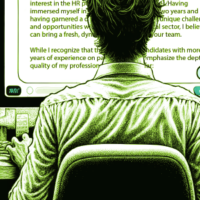
Staffing changes are a fact of life, not only for hiring managers but for the employees who seek new employment. Within the anti-money laundering (AML) profession, it is critical for employers to hire the most qualified individuals. Not only is the success of the AML program dependent on the skill level of associates performing high-profile tasks, but regulators expect each institution to have a staff of qualified, well-trained AML professionals. Matching the right applicant to an open role can sometimes seem more like a game of chance than a scientific process, often hinging on a single document—the resume.
The AML industry is a growth industry. The periodic reassessment by the Financial Crimes Enforcement Network of the definition of financial institutions and higher AML risk businesses, often results in the need for additional professionals trained to identify financial crimes. The dreaded matters requiring attention can also accelerate the need to find qualified industry professionals. Though the need for qualified financial crimes prevention specialists is constantly growing, it may be difficult to differentiate oneself in the pool of growing applicants for open roles. Given how competitive the job market is, a well-constructed resume is one sure-fire way to rise to the top of the applicant pool.
Below are some general tips to construct a resume that will provide the information needed by hiring managers to make a well-informed decision regarding your qualifications for the role.
Formatting
Let us first look at format:
- Use a resume template1—Templates accomplish two goals. First, templates force the writer to place key information in places hiring managers expect to find them. Second, templates use a columnar format, which saves space. Do not include images or headers/footers. Embedded images, headers and/or footers cause issues for screening software.
- Mirror, mirror—While it is important to tailor your resume to the role for which you are applying, it is equally important to ensure that the resume mirrors the company in which the role resides. “If you are applying to a position in a different industry (software), make your resume more innovative—use color, fun formatting, icons, etc.,” advises Ashley Crill, senior manager of human resources at Banker’s Toolbox. Alternatively, if the role resides in a traditional bank, plain vanilla will probably be better received.
- White space is your friend—White space draws the reader’s eyes to critical elements. Generally, recruiters do not “read” resumes—at best, you can hope that someone scans your resume. Avoid dense blocks of text. The goal is to immediately and succinctly identify for the reader why you are perfect for the role. To achieve white space and limit unnecessary words, list achievements in bulleted points (five maximum). Keep bullets to two lines maximum.
- Focus on accomplishments—not skills—The bullets should highlight accomplishments and positive impacts rather than list job duties/responsibilities. Select a maximum of five projects/accomplishments to list on the resume. Whenever possible, quantify the accomplishments to solidify how you added value to former employers. When drafting accomplishments, present the accomplishments in a “result by” structure. For instance: “Expanded responsibilities of investigative team by creation and implementation of templated review responses, which permitted the team to assist with higher risk customer reviews.”
- Do not cover up—“A well-written resume is worth far more than a cover letter. You get 30 seconds to wow someone with your resume. If you send a cover letter that eats into the time” says Crill of Banker’s Toolbox.
Content
Now, let us look at actual content2:
- Keep it short (one to two pages)—As previously stated, recruiters generally perform a very quick “spot check” of your resume. In general, limit your resume to one page if you have less than 10 years of experience and no more than two pages if you have more than 10 years of experience. A lengthy resume will not necessarily make you seem more impressive to the reader, but it will certainly force the reader to play hide-and-seek for the important details about your qualifications for the role. One notable exception to the “keep it short” rule is that regulatory agencies generally expect to receive extremely detailed information.
- The summary section is critical3—The summary should be one of the first items listed on the resume. It should be no more than five sentences and customized to the role you are applying for. Consider it your 30-second elevator pitch to the recruiter. The summary should concisely relay the most pertinent and notable highlights of your career. Remember, it is critical to grab the recruiter’s attention quickly because they likely will not take the time to read the entire document to get a sense of who you are.
- Be very subjective about the objectives section—The recruiter knows the type of role you are interested in because you have applied for a role at his/her company. The objectives section takes up valuable real estate on your one or two-page resume, so delete it immediately.
- Include a URL to your professional profile (e.g., LinkedIn) at your own risk—Considering the value of the space on your resume, give careful thought about including URLs. Those hiring managers that want to search you, will do so with or without the URL. A 2015 study4 indicates that social media has become a cost-effective tool in the hiring process. Ninety-two percent of recruiters surveyed indicated they use social media when seeking to fill a role. Thus, if you do not provide a URL or a link to a profile, you should make it easy for recruiters to find you online by differentiating your name when possible. For example, use a middle initial. Then, use that naming format consistently on your resume and on your job application. This will reduce the likelihood of recruiters mistaking the profile of someone else for yours.
- Imitation may just get you the job—Because many businesses use applicant tracking systems (ATS) aka computer screening, candidates would do well to customize a resume to the role applied for by ensuring to use keywords mentioned in the job posting. ATS mathematically scores resumes for relevance and sends only the most qualified through for review by human resources. A less recommended alternative—in lieu of customizing a resume for each role applied for—is that an applicant can identify the key words and phrases that are used routinely in the job descriptions and incorporate them into the resume. However, do not repeat the exact verbiage in the job description. Matching keywords will better assist an applicant makes it past the initial screenings and moves on to the next phase of the hiring process.
- Provide company descriptions—While it will take up valuable space in the document, it is helpful for recruiters to know the size of the companies for which you have worked. Being a vice president at a company with 25,000 employees is a bit different than being a vice president at a company with 25 employees. Keep the description short, but informative. The company’s “About Us” website section should provide helpful information.
- Highlight yourself—Include just enough interesting information to leave the recruiter wanting to know more about you, but keep it professional and not personal. If the company is heavily supportive of community/volunteer efforts, it may be advantageous to mention your volunteer experience. Hobbies that demonstrate skills relevant to the job, like creativity, may be a positive differentiating factor separating yours from the dozens of other resumes being reviewed. However, be careful. Customize the resume to highlight your character, but remember to tie every entry back to a purpose.
- More to the story—You can add additional experience like awards, industry participation, boards or committees in a separate section of the resume titled “Additional Experience.” Remember that brevity is a virtue. Focus on what matters most to the company or the role. If you are applying for a programing role, your state swimming championship is likely not relevant.
- Above all, be honest—“First of all, if you don’t tell the truth it could come back to haunt you—either before you get a job offer or in the future. There have been plenty of people fired years after the fact because they lied on their resume to get a job. Secondly, many, if not most, employers check at least basic references and if your employment history doesn’t jive with the information discovered during a background check you’re definitely not going to get hired.”5 Finally, no one wins when someone is hired into a role into which she/he cannot perform or succeed because the experience, skills or knowledge is just not there. Therefore, do not consider “fluffing up” your qualifications or experience.
Now that you have the basics for a resume, it is time to tailor the information to the financial crimes industry.
- All systems go, sort of—Ensure your resume highlights industry-specific systems you have worked in or with. When possible, list the experience you have with the system (e.g., implemented BAM+, including testing and setting parameters for a $4.3 billion community bank). Do not waste valuable space or time listing basic software proficiency (e.g., Microsoft Word). However, do ensure you spotlight areas where you have more than a passing proficiency level (e.g., expert in Microsoft Excel). Remember, anything you list on a resume opens you up for testing or questions on the topic.
- Defenses up—Your resume must provide detailed explanation of the previous positions you have held including the role played in the lines of defense. Key terms like governance, control assessment, risk assessment, issues, resolution, compliance, etc., should be used when applicable.
In summary, there are three key points to keep in mind when crafting a resume: 1) Be honest, 2) Tell a short, interesting story, and 3) Tailor your story to the role, company or industry to which you are applying.
- “This Is What A Good Resume Should Look Like,” CareerCup, https://www.careercup.com/resume
- Erin Greenawald, “43 Resume Tips That Will Help You Get Hired,” The Muse, https://www.themuse.com/advice/43-resume-tips-that-will-help-you-get-hired
- Daniel Bortz, “What Your Resume Should Look Like in 2016,” Time, January 11, 2016, http://time.com/money/4171054/resume-tips-advice/
- Kimberlee Morrison, “Survey: 92% of Recruiters Use Social Media to Find High-Quality Candidates,” SocialTimes, September 22, 2015, http://www.adweek.com/socialtimes/survey-96-of-recruiters-use-social-media-to-find-high-quality-candidates/627040
- Alison Doyle, “Why You Should Keep Your Resume Honest,” The Balance, September 18, 2015, https://www.thebalance.com/why-you-should-keep-your-resume-honest-2063304











